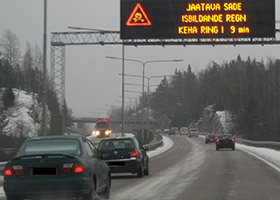According to a recent study, poor weather conditions increase the accident risk more on motorways compared to two-lane and multiple-lane roads. The study analysed the accident risk from a single drivers’ point of view and the relative accident risk was related to the time spent on the road segments.

Photo: VTT Technical Research Centre Ltd
The results show that the relative accident risks were, in general, highest for conditions with different types of snowfall or very slippery road surfaces. The accident risks were compared based on climate zone (coastal area, southern inland and northern inland) and road type (two-lane, multiple-lane and motorway).
According to the results, the accident risks for different road and weather conditions were higher on motorways than on two-lane and multiple-lane roads (Figure 1). At least when taking into account that the overall accident risk was low (around 0.8) on motorways compared to the other road types (between 1.0‒1.6). The accident risk was 2.6–2.7 times higher for snowfall and very slippery road conditions on motorways. When comparing the relative accident risks of different climate zone, no major differences were identified.
| Road condition | Two-lane road | Multiple-lane road | Motorway |
| Snowfall | 2.2 | 1.9 | 2.6 |
| Sleet | 1.1 | 1.4 | 2.3 |
| Slippery road | 1.8 | 1.5 | 2.1 |
| Very slippery road | 2.7 | 2.3 | 2.7 |
Figure 1. Relative accident risk for different weather conditions based on road type. Statistically non-significant results are faded.
Single-vehicle accidents related to high accident risks
The relative accident risks were further compared based on accident type (single-vehicle, multi-vehicle and animal accident) and accident severity (casualty and no casualty accident). The accident risks for different weather conditions were higher for single-vehicle accidents compared to the other accident types. There were only minor differences when comparing the risks based on accident severity.
Variable speed limits’ control rules are justified
The study supports the concept of controlling speed limits on motorways by weather and road conditions. The accident risk of variable speed limits control rules, i.e. different combinations of weather and road conditions, were compared. Most of the control rules’ categories and their conditions are justified. The control rules were paired with the road weather data and then the risk for each weather and road condition combination was calculated.
A new method for analysing accident risks has been developed during the past years at the VTT Technical Research Centre of Finland Ltd. In the method, the accident risk is analysed from a single driver’s point of view. The method is based on calculating the Palm distribution of different conditions to the accident distribution of the same conditions. When these distributions differ, the condition influences the accident risk. The study included accident, estimated traffic volume and weather data from 44 Finnish main roads during the years 2014–2016.
Report:
Identification of accident risk and its application in traffic control. Accident risks in different road weather conditions on Finnish main roads. Link to full report (in English)
Authors: Fanny Malin, Ilkka Norros and Satu Innamaa
 Contact:
Contact:
Fanny Malin
fanny.malin@vtt.fi
VTT Technical Research Centre of Finland Ltd






Follow us: